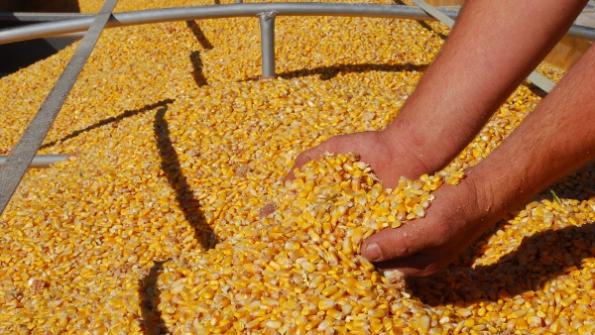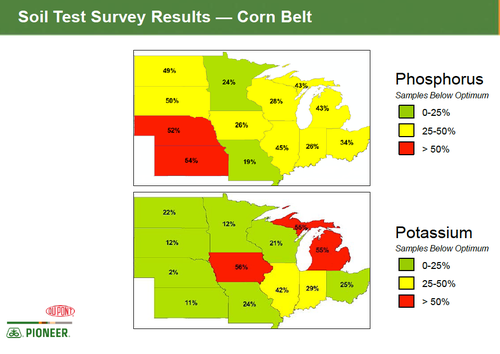October 28, 2016

It’s no secret that phosphorus (P) and potassium (K) levels in soil can get neglected when corn margins are tight. And according to more than 22,000 soil samples tested in 2016 by DuPont Pioneer agronomists across almost 9,000 Corn Belt fields, P&K deficiencies are keeping today’s productive genetics from reaching full yield potential.
DuPont Pioneer Growing Point agronomy program tested more than 22,000 soil samples across almost 9,000 Corn Belt fields in 2016. You can see phosphorus deficiencies were greater in the western Corn Belt states, and potassium shortages were larger in the “I” states – keeping today’s productive genetics from reaching full yield potential.
“For example, we sampled 2,000 fields in Iowa, and 31 percent were very low in potassium and another 26% were low, based on Iowa State University recommendations,” says Andy Heggenstaller, DuPont Pioneer agronomy research manager. “That means roughly 31 percent of those soils had an 85 to 100% probability of a yield response if potassium was applied, and the 26% of soils rated low had a 65% probability of a yield response.”
This 57% of 2016 samples in Iowa that were below optimum potassium levels is quite a bit higher compared to 39% of 2015 Iowa samples below optimum, according to International Plant Nutrition Institute study.
Millions lost
Heggenstaller calculated that this potassium deficiency alone cost Iowa corn growers approximately $4 billion dollars in lost revenue, not even counting potential soybean losses, too.

If you've had 70 bu. beans and 300 bu. corn, it'll take 567 lbs. maintenance P&K, compared to 390 lbs. needed with 50 bu. beans and 200 bu. corn.
Granted, university fertility recommendation levels vary across the Corn Belt, with only Iowa State and Wisconsin having updated their recommendations in the last five years, Heggenstaller says. So the percentages of soil test levels can vary by state, especially if older recommendations are used.
Heggenstaller mentioned that low levels of potassium really start showing up in late August with stalk lodging, since this nutrient is critical to promote stalk strength and standability.
Understandably, Pioneer is concerned with customer fertility levels that can impact hybrid performance. “We want to see our premium products get managed the right way to capture all the value we bred into them,” Heggenstaller says. “That’s where our Encirca variable rate fertility management service helps allocate nutrients and maximize return in each field zone to drive profitability.”
Watch nutrient removal
Over the last three years, the U.S. corn crop has had above trendline yields, which has also increased nutrient removal. “We encourage farmers and their fertilizer advisors to soil sample and really take a serious look the yield goal in that fertility calculation. For example, if you’ve been fertilizing for 180 to 190 bushels and the crop has been doing 225 for four years in a row, soil is being depleted,” he says.
Even on rented ground, Heggenstaller advises against basing fertilizer application on crop removal only, “because you can shortchange your yields, even during the current crop year.
About the Author(s)
You May Also Like






